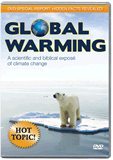Conservation Clashes
Originally published in Creation 24, no 2 (March 2002): 5.
Last issue’s environment article got the most response. Most of the “anti” letters believed we had been “taken in” by environmentalist propaganda using poor science. We have no agenda in this, and try to take a balanced view. In fact, we have long stocked Mike Oard’s book Weather which takes a sceptical view of greenhouse, etc. We would therefore have been happy to publicize here any objections of substance. But none of the alleged problems seem to compel allegiance; we list the main ones here, followed by comment in brackets.
- Ozone (O3) is formed by UV light’s action on O2, so it can’t protect from UV light. [The wavelengths involved differ in each case. O3’s UV-blocking properties are based on straightforward measurement.]
- Water vapour’s greenhouse properties are so much greater than CO2 as to render man-made increases in the latter negligible. [No quantitative data was supplied. We mentioned water’s greenhouse effect first—it’s well known to physicists on all sides of the debate.]
- The CO2 readings from Mauna Loa are ruled out because of the nearby active volcano. [The rising atmospheric CO2 trend (i) is expected from commonsense chemistry (ii) spans decades and (iii) is mirrored by sampling from several widespread locations.]
- Volcanoes produce gases which also react with the ozone layer, so why ban CFC (refrigerant) gases? [Is this like saying, “Why quit smoking, since a lot of cancer is already produced by natural radiation?” But in any case we did not support or oppose CFC bans.]
- CFCs are much heavier than air, so they can’t rise high enough to affect the ozone layer. [This ignores actual upper atmospheric sampling. Gases tend to mix. Ozone is much heavier than air, but it’s “up there’, too.]
- When ice floating in a glass melts, there is no change in water level, thus melting icecaps will not raise sea level. [(i) Much of the Antarctic ice sits on land; (ii) Expansion of warmer seas is a major reason for predicting sea level rise.]
Brad Pemberton of Georgia, USA, loved the article, adding that Lake Superior used to be thought the world’s largest freshwater lake when surface area was the criterion, but Lake Baikal is cited today for its bigger volume. However, “both Lakes Baikal and Superior are dwarfed by Lake Michigan-Huron” (these two lakes, he says, are technically one since the water flows both ways between them) in both area and volume.
Mike McDaniel of Texas, USA, addressed the sidebar commentary “20% of the world’s population consumes 80% of its resources”, pointing out that a horse-drawn plow uses no diesel, but capitalist farmers feed much of the world. For the record, we also pointed out the shocking pollution history of socialist countries.
Argon anxieties
The Mount St Helens radiodating article (Creation23(3):23-25) drew some attacks from long-agers who generally missed the point. Of course the “millions of years” dates from this recent volcanic rock were because the sample contained some non-radiogenic argon. But a prime assumption in potassium-argon dating is that there is no non-radiogenic argon present (note that radiogenic and non-radiogenic 40Ar are identical). Thus one of the assumptions of the method has failed the test. Put another way—if experiments like those we often publish consistently show that one can’t trust the method on rocks of known age, how is it rational to believe the “millions of years” results for rocks of unknown age?
Day dreamers
Thanks to Haddorn Thorn of Essex, England, for gently pointing out that on p. 39 of Creation24(1), “Days 4 and 5” should have read “Days 5 and 6”. Of course, no animals were created on Day 4. Blush.
Recommended Resources

Answers in Genesis is an apologetics ministry, dedicated to helping Christians defend their faith and proclaim the good news of Jesus Christ.
- Customer Service 800.778.3390
- Available Monday–Friday | 9 AM–5 PM ET
- © 2025 Answers in Genesis



